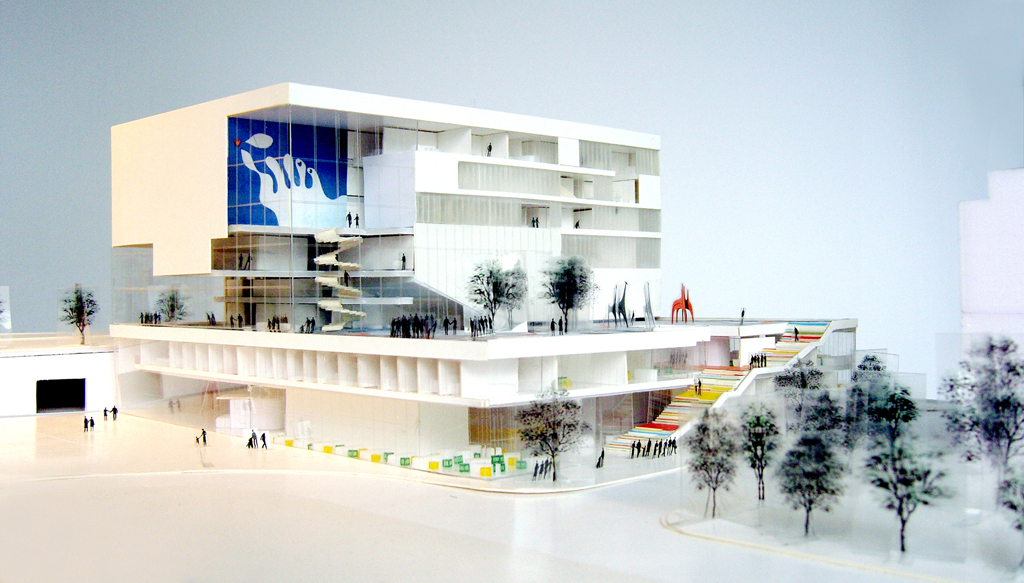The House of Arts and Culture appears at exactly the right moment to boost the already sizzling creativity of Beirut ever since the end of the period of violence in Lebanon between 1975 and 1990. Beirut never ceased to be a place of freedom of thought. Beirut was home to the first universities of the Middle East and was the birthplace of modern Arabic literature. The sultanate of Oman granted USD 20 million to help funding the House of Arts and Culture.
After studying the brief of the competition, it was a surprise not to encounter the word Icon once. The brief talks about a strong presence, a recognisable character, an exceptional architecture …but also about banning words such as: rigidity, routine, or static. The current architecture production of icons has resulted in rigid and static buildings that somehow quickly became part of the routine.
The architecture of The House should not restrict or confine any potential for creativity. It should allow maximum flexibility and it should represent the dynamism of Art and Culture in Beirut day after day.
Let us escape from the conventional and megalomaniac icon and reinvent the way a city and its culture are represented. The House of Arts and Culture cannot be a static depiction of a single moment in time. It must be dynamic, changeable; like a machine, it should reveal the essence of transformation.
The site of the House of Arts and Culture will be surrounded by iconic towers in the near future. The area will have a high density of occupation. The Masterplan by Solidere does not contemplate the creation of a public space to act as a connector of all the elements, to provide a place for public life in the area.
By studying meticulously the required programme we find the optimal organization, which is effective and compact, and therefore we can free half of the area from the height of 10m to transform it into an elevated Plaza that will work with the small existing square, creating a vital public space in the neighbourhood. This urban strategy and the extremely versatile design of the main performance box were the features that won the project a prize in the competition.
Horizontal and Vertical: The Box and the Plinth
The programme is grouped according to its qualities. By dividing the functions into two categories according to their requirements on height and street interaction, we obtain two volumes: a tall Box and a low Plinth. By keeping the plinth as low as possible, we ensure maximum urban conditions, both in the surroundings and within the plinth itself.
The Box can host hundreds of different event configurations (Italian, kabuki, No theatre, techno party, mega banquet, exhibitions, conferences, lectures, dance evenings, poetry recitals, fashion shows, concerts, markets, fairs…).
The Plinth hosts all the programmes on two levels, connected physically and visually, allowing for the maximum interaction between the functions on the inside and maximum connection with urban life outside. By concentrating the entire plinth programme on two levels, we minimize the use of the elevator so functions can be continued without interruptions.
Urban context
The urban context of the House is shaped by a very busy road, a small quiet plaza, and two as yet unknown future iconic buildings of 40m and 150m in height.
The back of the Box will be facing the ring road. Its closed façade will block out the noise of the road and the southern sun while it becomes a large billboard visible from thousands of cars and pedestrians along the ring. It can act as a screen for a projected movie, or be rented for advertisements on certain occasions to generate extra funding
The elevated Plaza in the north is protected from the noise and the afternoon heat – and enjoys the morning sun. At a height of 10 m the Plaza becomes a podium for concerts, a platform for exhibitions… a lively space, facing the existing square.
The exhibition hall, the lounge, and the café are placed along the pedestrian route in the East, animating the future street, once the tunnel under the ring is open. The foyer of the halls will run at 10m height parallel to this street. The service entrance and the delivery zone will be on the west side, which will be almost closed to avoiding the strong sun radiation.
The House can work as one single building with a main entrance hall that gives access to each function: exhibition, café, shop, library, performance halls, etc… But it can also work as seven independent elements with direct access from the outside. This contributes to the easy management, allowing one or many parties.
Reinvention of the performance hall: the Magic Box
The performance hall of The House in Beirut demands a large number of possible configurations each of different character and with different requirements. None of the existing theatre models can accommodate such a range of events; therefore, we need to look for a new one. We call it The Magic Box. Just a few changes in the traditional box will be enough to make it flexible and much more useful:
A- Keep the fly tower height in the entire room, to liberate the position of the stage.
B- Lift floor system in the entire room, not just the stage.
C- Provide the hall with the possibility of enlargement by placing the other rooms adjacently, so that on certain occasions their dividing wall can be opened and they may be combined to host larger events in a spectacular configuration.
The big performance hall enjoys a free height of 20 meters. In this way, we no longer distinguish between fly tower, stage, and the stalls; these three elements can change location for each new performance.
STAR strategies+architecture
www.st-ar.nl





















